Day 1 :
Keynote Forum
Tatiana Morosuk
TU Berlin, Germany
Keynote: Regasification of LNG: Actual status and perspectives
Time : 09:35-10:15

Biography:
Tatiana Morosuk is professor of the Technische Universität Berlin, Germany (since 2013). She studied refrigeration engineering in the Odessa State Academy of Refrigeration, Ukraine, and received her Diploma in 1990, Ph.D. in 1994 and Professorship in 2001. Her field of scientific activities is the application of exergy-based methods to the analysis and improvement the thermodynamic, economic, environmental performance of different power generation systems, refrigeration/cryogenic systems and chemical plants. Particular attention is given to systems associated with the liquefaction of natural gas and the regasification of LNG, smart energy supply and use in industrial parks, including innovative concepts of liquid air energy storage. She is the author or co-author of 7 books and more than 250 publications, and has 10 patents. She has over twenty years of experience and related teaching experience in the fields of refrigeration and over ten years in the field of applied thermodynamics, energy engineering, exergy-based methods.
Abstract:
Statement of the Problem: The overall chain “natural gas − LNG – natural gas” can be divided into four blocks: (a) Export terminal with associated technology for natural gas liquefaction (LNG production),
(b) LNG transport, (c) import terminal using a regasification process, and (d) distribution of the natural gas. Each of those four blocks is associated with energy-intensive processes. During the last two decades the total cost of LNG technology has decreased significantly due to improvements of the liquefaction process. However, the regasification system has not been considerably improved. It is known, that for the conventional regasification process (indirect heat transfer process, for example open rack vaporizers, submerged combustion vaporizers) about 1.5 % of the LNG energy is used. Findings: The integration of LNG regasification into heat utilization systems of an industrial process, LNG-based cogeneration for electricity generation, and LNG-based cogeneration for chemical products will bring benefits for the entire co-generation system (or industrial park) from thermodynamic, econonmic and environmental poits if view. Methodology: Exergy-based methods are applied for analysis, evaluation and improvement the thermodynamic, economic, environmental performance of actual and innovative systems for regasification of LNG. Conclusion & Significance: LNG will have in future a significantly larger contribution to the energy supply in the world than it had in the past. Thus, applying thermodynamically efficient, cost effective, and environmentally benign plants for the regasification of LNG is of particular importance for the use of LNG.
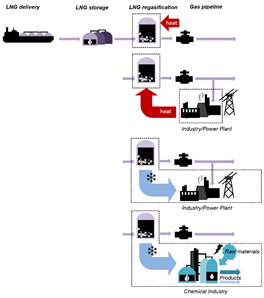
Figure 1: Options for the regasification of LNG
Recent Publications
- Morosuk T, Tsatsaronis G (2012) LNG – Based Cogeneration Systems: Evaluation Using Exergy-Based Analyses. Chapter 11 “Natural Gas - Extraction to End Use” (Ed. SB Gupta), InTech: 235-266.
- Tsatsaronis G, Morosuk T (2015) Understanding the Formation of Costs and Environmental Impacts Using Exergy-Based Methods. Chapter 18 “Energy Security and Development. The Global Context and Indian Perspectives” (Eds. BS Reddy, S Ulgiati), Springer, New Delhi, India: 271-292.
- Tesch S, Morosuk T, Tsatsaronis G (2016) Advanced exergy analysis applied to the process of regasification of LNG (liquefied natural gas) integrated into an air separation process, Energy – The International Journal 117: 550-561.
- Morosuk T, Tsatsaronis G (2016) Comparison of novel concepts of cogeneration systems used to regasify Liquefied Natural Gas (LNG), Journal of Natural Gas Science and Engineering 34: 1434-1445.
- Morosuk T (2016) Guest editor “Practice and innovations in the regasification of LNG, Energy – The International Journal 105.
Keynote Forum
Jinsheng Wang
CanmetENERGY, Natural Resources Canada
Keynote: Enhanced recovery of shale gas with CO2 storage in gas-depleted shale
Time : 10:15-10:55

Biography:
Jinsheng Wang is a Research Scientist of CanmetENERGY, Natural Resources Canada. His research interest spans several areas, including unconventional oil and gas, greenhouse gas control, clean energy processes, oil processing, etc. He has obtained his BSc from Beijing Institute of Chemical Technology, China, MSc from Institute of Aeronautical Materials, China and PhD from Kyoto University, Japan. He has been working in Natural Resources Canada since 2000.
Abstract:
For shale gas development, low recovery factor and greenhouse gas emissions are two important issues. The average recovery factor for shale gas is around 10%, resulting in a large footprint with only a small portion of the resource recovered. Meanwhile, emissions of methane, a potent greenhouse gas could undermine the global efforts of reducing greenhouse gas emissions into the atmosphere. Injection in shale gas fields of CO2 captured from industrial emitters such as fossil-fuel power plants could increase the recovery of shale gas and achieve CO2 storage in gas-depleted shale. This could obtain carbon credits and improve the economics for shale gas production. It may also turn gas-depleted shale into a sink of CO2 and contribute to reduction of greenhouse gas emissions. In shale gas field, methane exists as free gas in void space and as adsorbed gas on organic matter. Injected CO2 could push the free gas toward the production well and displace the adsorbed gas because CO2 has a higher tendency to be adsorbed compared to methane. As a result CO2 is trapped in gas-depleted shale to enable CO2 storage. CO2 could also drive out gas condensate that is trapped in the shale and impedes the gas flow. As part of our research on enhanced shale gas recovery with storage of CO2, we have carried out sorption experiments for CO2 and methane. The results with samples from a Canadian shale gas reservoir suggest that the shale could adsorb 10 times more CO2 than methane. That is to say, with every cubic meter of methane produced, 10 cubic meters of CO2 could be stored. We have also studied swelling of gas condensate by CO2, which could mobilize the trapped condensate and facilitate the gas flow. Other interesting findings will also be presented.
Figure 2. Time dependence of the size of gas condensate drop.
Recent Publications
- Wang Z, Wang J, Lan C, He I, Ko V, Ryan, D., Wigston, A (2016) A study on the impact of SO2 on CO2 injectivity for CO2 storage in a Canadian saline aquifer. Applied Energy 184:329-336.
- Wang J, Wang Z, Ryan D, Lan C (2015) A study of the effect of impurities on CO2 storage capacity in geological formations. International Journal of Greenhouse Gas Control 42: 132-137.
- Ng S, Al-Sabawi M, Wang J, Ling H, Zheng Y. Wei Q, Ding F, Little E (2015) FCC coprocessing oil sands heavy gas oil and canola oil. 1. Yield structure. Fuel 156:163-176.
- Wang J, Ryan D, Anthony EJ, Wigston A (2012) The effect of impurities in oxyfuel flue gas on CO2 storage capacity. International Journal of Greenhouse Gas Control 11: 158-162.
- Wang J, Ryan D, Anthony EJ (2011) Reducing the greenhouse gas footprint of shale gas. Energy Policy 39: 8196-8199.
Keynote Forum
Kashy Aminian
West Virginia University, USA
Keynote: Experimental Evaluation of the Marcellus Shale Properties
Time : 8:00-8:30

Biography:
Kashy Aminian, Professor of Petroleum & Natural Gas Engineering at West Virginia University, has 40 years of distinguished service in both industry and academia. He holds MS and PhD degrees both from University of Michigan. He has extensive research and teaching experience in the areas of unconventional natural gas resource development and reservoir engineering.
Abstract:
Unconventional shale reservoirs play an enormous role in hydrocarbon production in the United States. Among the shale gas producing plays, Marcellus shale has a growing contribution due to advances in horizontal drilling and hydraulic fracturing techniques. Even though the advances in these technologies have unlocked the gas contained in Marcellus shale, the quantification of the petrophysical properties remain challenging due to complex nature of the shale. Reliable values of the shale petrophysical properties including permeability and porosity are necessary for accurate estimation of the original gas-in-place, prediction of the production rates, and optimization of the hydraulic fracturing treatments. Unsteady state methods have been extensively used to estimate permeability of the shale samples because the shales typically have permeability values in Nano-Darcy range. However, the permeability values by determined by these techniques have been found often to have large margin of uncertainty which are attributed to the lack of consistent experimental protocols and the interpretations issues.
Figure 1. Schematic of PPAL
Recent Publications:
- Elsaig, M., Aminian, K., Ameri, S. and M. Zamirian, 2016: “Study Analyzes Marcellus Shale Petrophysics,” American Oil & Gas Reporter, November Issue, pp. 63-65.
- Zamirian, M., Aminian, K. and S. Ameri, 2016: “Measuring Marcellus Shale Petrophysical Properties,” Paper SPE-180366, Proc. SPE Western Regional Conf., Alaska.
- Zamirian, M., Aminian, K., Ameri, S., 2015. “Measurement of Key Shale Petrophysical Properties.” Paper SPE 174968 Proc. SPE ATCE, Houston, Texas.
- Zamirian, M., Aminian, K., and Ameri, S., 2015. “Experimental Investigation of Geomechanical Impacts on Organic-Rich Shales Matrix-Fracture Characterization,” Paper SPE-1733028, Proc. SPE Eastern Regional Conference, Morgantown, WV.
- Zamirian, M., Aminian, K., Ameri, S., 2014. “New Steady-State Technique for Measuring Shale Core Plug Permeability.” Paper SPE-171613, Proc. Unconventional Resources Conference, Calgary, Canada.
- Biofuels and Hydrocarbons | Downstream Developments | Environmental Impatcs and Effects | Global Oil & Gas Reserves | Health, Safety & Risk in an Organizational Context | Midstream Operations
Location: Berlin, Germany

Chair
Fawzi Banat
Petroleum Institute Abu Dhabi, UAE

Co-Chair
Emad Elnajjar
United Arab Emirates University, UAE
Session Introduction
Manal Hamad Al-Amiri
Kuwait Oil Company, Kuwait
Title: Health, safety and risk within the Kuwait Oil Company context
Time : 11:55-12:20

Biography:
Manal Hamad Al-Amiri has 19 years of Civil/Structural Engineer experienced in designing building and structural elements and has experience of numerous computer analyses (like STAAD and RISA) and drafting Civil Engineering Contracts (FEED Packages) for several civil buildings/structures within oil and gas field. Currently she is working in Kuwait Oil Company as a Projects Support Services Group (Major Projects).
Abstract:
As one of the oil and gas companies, Kuwait Oil Company (KOC) is fully committed in protecting the health and safety of its employees, including contractors, visitors and the environment in the communities where it operates. KOC recognizes that by integrating health, safety and environment leadership into all aspects of its business, the methods of harvesting Kuwait oil and gas resources can be improved for the benefit of the state of Kuwait and its employees and customers. Therefore, KOC has developed 11 HSE System elements to be followed by its employees. These elements are: Leadership Commitment and Accountability (Element 1): People at all levels are responsible for leading and encouraging the workforce to meet health, safety, technical integrity and environment goals and objectives. Training, Competency & Behavior (Element 2): KOC workforce are carefully selected and trained, certified as required and their skills and competencies regularly assessed. Risk Assessment, Compliance and Management (Element 3): KOC regularly identify hazards, asses and manage the risks associated with its activities, maintain programs to identify communicate and comply with HSE laws, regulations and other obligatory requirements. Facilities Design & Construction (Element 4): New and existing facilities designed, procured, constructed and commissioned to be safe, secure, and healthy and environmentally sound while they are in operation by using recognized standards, procedures and management system. Operation and Maintenance (Element 5): Facilities are operated and maintained within the current design. Management of Change (Element 6): KOC comply with changes to laws and regulations and take account of new scientific evidence relating to HSE effects. Crises Preparedness and Management (Element 7): Emergency management plans are maintained to cover all facilities, locations and activities. These plans will identify equipment, training and personnel necessary to protect the workforce, customers, public, environment and KOC reputation in the event of an incident. Incident Analysis and Prevention (Element 8): All incidents are reported, investigated and analyzed to prevent recurrence and improve KOC HSE performance. Investigations will focus on root causes and /or system failures. Corrective actions and preventive measures will be utilized to prevent further injuries and losses. Communication and Reporting (Element 9): KOC actively engage in dialog with stakeholders to receive public feedback, maintain public confidence in the integrity of its operations and to communicate HSE performance. Internal communication is essential between various KOC (departments) regarding HSE expectations and performance. Contractors and Vendors (Element 10): Contractors and vendors are keys to KOC business performance and KOC will assess their capabilities and competencies to perform work on its behalf. KOC will work together with contractors as partners to ensure HSE requirements are fully implemented. Information and Documentation (Element 11): KOC will maintain information management systems to augment the effective implementation and maintenance of the HSEMS. Documentations and document control process will support effective HSE performance by ensuring access to current information for the execution of HSE responsibilities, as well as ensuring continuity and consistency over time.
Emad Eldeen Jamil Elnajjar
United Arab Emirates University, UAE
Title: Morphology characterization and chemical composition of UAE date seed and its potential for energy production

Biography:
Emad Elnajjar is an Associate Professor in Mechanical Engineering Department at UAE University. He has earned his PhD degree in the field of Aerospace Engineering from Illinois Institute of Technology, Chicago IL, 2000. His research areas of interest are: Combustion, emission and control biofuels, system integration, energy management, renewable energy, experimental thermal fluids, micro-heat exchangers, LHP and carbon nanotubes synthesis.
Abstract:
This study was carried out to investigate the morphological characterization, the chemical composition and the percentage of the extracted oil of date seed powder with average size of 0.1<DS<0.3 mm. The date seed powder morphology was determined by employing scanning electron microscope (SEM). The Chemical composition by means of inductively coupled plasma atomic emission spectroscopy (ICP-AES), it was used for the detection of trace metals. The bomb calorimeter was used for determining the lower heating values. Thermo-Gravimetric Analyzer (TGA) by monitoring the mass losses of samples determined by pyrolysis the date seed powder samples in an inert condition. The date seeds of two types of date palm from United Arab Emirates (UAE), Khalas and Allig were considered for this study. By means of approximate analysis the following percentage contents of Khalas date seeds powder were determined, an average for moisture, volatile and protein , volatile and lipids, carbohydrate, and ash were varied from 7%, 40%, 23%, 13% and 17% respectively. Meanwhile, for the Allig the approximate analysis results were an average for moisture, volatile and protein, volatile and lipids, carbohydrate, and ash were varied from 3%, 49%, 15%, 13% and 20% respectively. The ICP analysis resolved a total trace of metal components of 3.2%. the lower heating value of the Khallas and Allig powder measurements were 23 kJ/kg, 21 kJ/Kg respectively. Both Date seed types exhibits an amount of oil extraction of an average of 9.5%. Based on the study finding the palm date seed with its high energy density demonstrates a promising potential as a source for energy production among other nonedible organic product.
Fawzi Banat
Petroleum Institute. UAE
Title: Experimental study and scale up of adsorption column for reclaiming lean methyl diethanolamine solvent from natural gas sweetening unit
Time : 12:45-13:10

Biography:
Fawzi Banat is a Professor and Chair of Chemical Engineering Department at Khalifa University of Science and Technology, Petroleum Institute. He has obtained his PhD (Chemical Engineering) at McGill University, Canada, in 1995. Area of his research interests include gas and water treatment. He has received several research awards, published over 120 papers and holds a number of international patents.
Abstract:
Foaming and solvent degradation is a major issue in natural gas sweetening unit. Currently, GASCO Company (Abu Dhabi) is using aqueous methyl diethanolamine (MDEA) to scrub H2S/CO2. Adsorption is mostly applied technology to regenerate MDEA. Polymeric/clay hybrid composite were used in continuous adsorption to remove contaminants using different column diameter and height. This study focusses on the removal of organic acid anions as major contaminant present in lean MDEA. Dimensional analysis has been carried out in order to identify the relevant dimensionless groups involved to provide scale up studies. The adsorption column bed diameter and bed height was changed from 1.5-2.6 cm and 10-45 cm, respectively. The columns with 2.6 cm diameter having 10, 23 and 45 cm height were filled with different weight of adsorbents. It was observed that with increasing bed diameter the breakthrough as well as bed saturation time was increased. The breakthrough curve for lower diameter column was observed to have a sharp slope and shortened mass transfer zone. The bed height of 10 cm had faster breakthrough as compared to 23 and 45 cm bed height. Thus, higher the bed height, higher is the breakthrough as more amount of lean MDEA can be treated. Thomas and Yoon-Nelson models were used for analyzing the experimental data. For the scale up studies, the concentration of the contaminants in the column was approximated into two zones: A large saturated zone and a smaller unused zone. Then assumptions were made for laboratory to pilot scale that when the column gets longer, the size of the saturated zone will change but the size of the unused zone remain constant. While, for industrial scale both the zones will increase accordingly. The findings of this research could contribute to the industrial scale up for the purification of lean MDEA.

Recent Publications:
- Crittenden JC, Berrigan JK, Hand DW (1986) Design of rapid small-scale adsorption tests for a constant diffusivity, Journal of Water Pollution Control Federations 58: 312-319.
- Lin SD (2007) Water and wastewater calculations manual, 2nd Edition, McGraw Hill, 442-443.
- Corwin CJ, Scott SR (2010) Scaling trace organic contaminant adsorption by granular activated carbon. Environmental Science and Technology 44:5403-5408.
- Yan G, Virarghavan T, Chen, M (2001) A new model for heavy metal removal in a biosorption column. Adsorption Science and Technology 19:25-43.
- Werner D, Karapanagioti HK, Sabatini DA (2012) Assessing the effect of grain scale sorption rate limitations on the fate of hydrophobic organic groundwater pollutants. Journal of Contaminant Hydrology 129-130: 70-79.
Leema Abd Al-Rahman Al-Makhadmeh
Jordan University of Science and Technology, Jordan
Title: Oil shale combustion under oxy-fuel conditions
Time : 14:10-14:35

Biography:
Leema Abd Al-Rahman Al-Makhadmeh is currently working as an Associate Professor at the Department of Environmental Engineering, Al-Hussein Bin Talal University and Department of Chemical Engineering, Jordan University of Science and Technology, Jordan. She has completed her BSc and MS degrees from Jordan University of Science and Technology and PhD degree from Stuttgart University, Germany. Her research areas are oxy-fuel combustion, pyrolysis and char combustion, emission control technologies (NOx, SOx, PM) and others.
Abstract:
Direct combustion of Jordanian oil shale under oxy-fuel conditions was investigated. Unstaged and staged air-firing as well as combustion at 27% O2/73% CO2 (OF27) was conducted successfully. A 20 kW vertical reactor was used at a combustion temperature of 1200 oC. Oil shale-N conversion rate to NO is higher during unstaged air-firing than oxy-fuel combustion; they are 27% and 15% for air-firing and OF27 combustion, respectively. NOx emission reduced efficiently by adopting staged combustion technology under oxy-fuel conditions as well as air-firing. In addition, the reduction of simulated recycled NO has been investigated. The actual situation has been simulated by injecting NO in the reactor through the burner during OF27 combustion. The reduction of the injected NO is more efficient with staging compared to unstaged combustion mode; 100% reduction of the injected NO during staged OF27 combustion is registered while for unstaged OF27 combustion it ranges from 57% to 65%. The high sulfur content in Jordanian oil shale is considered one of the biggest challenges for its utilization. The oil shale-S conversion rate to SO2 is lower during unstaged OF27 combustion compared to air-firing; they are 69% and 49% for air-firing and OF27 combustion, respectively. For both unstaged combustion modes, direct limestone injection at different molar Ca/S ratios has been investigated; SO2 emissions are reduced significantly by direct limestone injection. At Ca/S molar ratio of 3, the desulfurization efficiencies are 100% and 95% for OF27 combustion and air-firing, respectively.
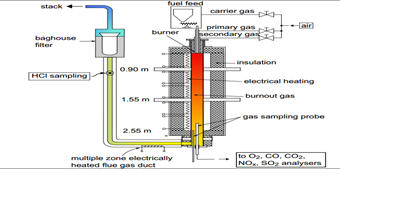
Recent Publications:
- Al-Makhadmeh L., J. Maier, MA Batiha and G. Scheffknecht (2017) Oxy-fuel technology: Oil shale desulphurisation behaviour during staged combustion. Fuel, 190, 229–236. Online on 26/11/2016.
- Al-Makhadmeh L., MA Batiha (2015) Removal of Iron and Copper from Aqueous Solutions Using Jordanian Kaolin and Zeolitic Tuff. Desalination and Water Treatment, 2015. 1-14.
- Al-Makhadmeh L., J. Maier, M. Al-Harahsheh and G. Scheffknecht (2015) Oxy-fuel technology: Oil shale desulphurisation behaviour during unstaged combustion. Fuel, 158, 460–470.
- Mohammad Al-Harahsheh, Awni Al-Otoom, Leema Al-Makhadmah, Ian E Hamilton, Sam Kingman, and Sameer Al-Asheh (2015) Pyrolysis of Poly(vinyl chloride) and –Electric Arc Furnace Dust Mixtures. HAZMAT, Jun 25; 299: 425-436.
- Al-Makhadmeh L., J. Maier and G. Scheffknecht (2014) Oxy-fuel technology: NO Reduction During Oxy-Oilshale combustion. Fuel, 128, 155–161.
Jing Zhu
China University of Petroleum, China
Title: Adsorption dynamics and rate assessment of volatile organic compounds in active carbon
Time : 14:35-14:55

Biography:
Jing Zhu has received her BSc degree from China University of Petroleum, China in 2011. She is currently working toward her PhD degree in Material Science and Engineering at China University of Petroleum, Beijing, China. Her research interests focus on the application of THz waves.
Abstract:
Volatile organic compounds (VOCs) emanated from car spills and oil and gas development can have mutagenic and carcinogenic effects on human beings. Adsorption using activated carbon with high specific surface area and large pore volume was one of the most widely used and mature methods to recycle VOCs. In this paper, an investigation was presented about terahertz time-domain spectroscopy (THz-TDS) as a novel tool for the characterization of the dynamic adsorption rate of volatile organic compounds, including isooctane, ethanol, and butyl acetate, in the pores of active carbon. The THz-TDS peak intensity (EP) was extracted and corresponded to the measurement time frames. By analyzing EP with time, the entire process could be divided into three physical parts including volatilization, adsorption and stabilization so that the adsorption dynamics could be clearly identified. In addition, based on the pseudo-second-order kinetic model and the relationship between EP and time in the adsorption process, a mathematical model was built in terms of the adsorbed rate parameter and the THz parameter. Consequently, the adsorption rate of isooctane, ethanol and butyl acetate could be assessed by the THz measurement, indicating that THz spectroscopy could be used as a promising selection tool to monitor the adsorption dynamics and evaluate adsorption efficiency in the recovery of pollutants.

Recent Publications
- Jing Z, et al. (2016) Adsorption dynamics and rate assessment of volatile organic compounds in active carbon. Physical Chemistry Chemical Physics 18:27175-27178.
- Honglei Z, et al. (2015) Water adsorption dynamics in active carbon probed by terahertz spectroscopy. RSC Advances 5:14389-14392.
- Jing Z, et al. (2016) Evaluating the characteristics of unconventional hydrocarbon resources with terahertz technology. Scientia Sinica 46:084201.
- Honglei Z, et al. (2016) Monitoring PM2.5 in the Atmosphere by Using Terahertz Time-Domain Spectroscopy. Journal of Infrared Millimeter and Terahertz Waves 37: 929-938.
- Honglei Z, et al. (2015) Less than 6 GHz resolution THz spectroscopy of water vapor 58:2104-2109.
Yizhang Li
China University of Petroleum, China
Title: Reaction-free evaluation of oil shale semicoke with terahetz domain spectroscopy
Time : 14:35-15:15

Biography:
Yizhang Li was graduated from Tianjin University in 2013 and is currently a Doctoral candidate in China University of Petroleum, Beijing, China. He majors in material science and engineering and focuses on characterizing oil shale with optical measurement.
Abstract:
Oil shale is widely viewed as important supplementary resource for petroleum. The quality of oil shale from certain region is conventionally assessed with maximum oil yield by Fischer Assay while the results may be different due to specific pyrolysis conditions. To determine utmost oil yield using non-chemical method is free from reaction interference and time-saving. In this study, we applied different combinations of pyrolysis temperature, heating rate and ventilating rate to process pulverized oil shale from Longkou, China so as to reserve various amount of organic matter. During pyrolysis, covalent bonds within kerogen of oil shale were subject to damage and thus shale oil and gas with light molecular weight formed. However, pyrolysis temperature was not sufficient to change inorganic mineral matrix. Therefore, the remaining organic matter of semicoke was distinct while the mineral matrix was alike. All of semicoke was compacted under same conditions to meet requirement of following optical experiments. Terahertz time domain spectroscopy was employed to detect semicoke tablets. According to the absorption of semicoke to terahertz wave, it was found that the transition of yield-condition dependence was in consistent with absorption-condition dependence. We had analyzed influence of pyrolysis temperature, heating rate and ventilating rate to Fischer Assay. Briefly, it turned out that rise of pyrolysis spanning from 400 °C to 550 °C facilitate shale oil production. Besides, optimal values were found for both heating rate as well as ventilating rate at 15 °C/min and 0.6 L/min, respectively. Such a transition for oil yield was related to secondary cracking, which was verified by data on pyrolysis products. As organic matter own distinct response to terahertz wave, the artificial maturation process can be characterized with optical parameter in terahertz range and this feature allows for the chance that optimization of pyrolysis efficiency based on terahertz time domain spectroscopy.
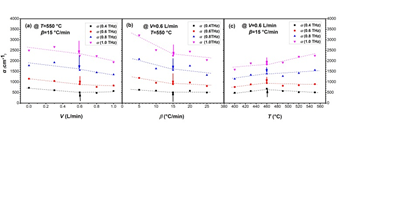
Recent Publications:
- Bao, R. M., Yizhang, L. I., Zhan, H. L., Zhao, K., Wei, W., & Yue, M. A., et al. (2015). Probing the oil content in oil shale with terahertz spectroscopy. Science China Physics, Mechanics & Astronomy, 58(11), 114211-114211
- Bao, R. M., Miao, X. Y., Feng, C. J., Zhang, Y. Z., Zhan, H. L., & Zhao, K., et al. (2016). Characterizing the oil and water distribution in low permeability core by reconstruction of terahertz images. Science China Physics, Mechanics & Astronomy, 59(6), 1-2.
- Miao, X. Y., Zhan, H. L., Zhao, K., Li, Y. Z., Sun, Q., & Bao, R. M. (2016). Oil yield characterization by anisotropy in optical parameters of the oil shale. Energy Fuels 30:10365−10370.
- Gao, S. C., Yuan, Z. W., Zhan, H. L., Miao, X. Y., Yizhang, L. I., & Zhao, K., et al. (2016). Terahertz spectral features and quantitative analysis of minerals in Ordos Basin Yanchang formation. Scientia Sinica,46(3), 034202.
- Li, N., Zhan, H., Zhao, K., Zhang, Z., Li, C., & Zhang, C. (2016). Characterizing pm 2.5, in Beijing and Shanxi province using terahertz radiation. Frontiers of Optoelectronics, 9(4), 1-5
Yan Song
China University of Petroleum, China
Title: Characterization of oil-water two-phase flow based on terahertz time-domain spectroscopy
Time : 15:15-15:35
Biography:
Yan Song has her expertise in the evaluation and characterization of fluid (microfluidic) flow in the oil and gas field based on new optical method. Her research of oil-water two-phase flow based on terahertz time-domain spectroscopy makes supplement of flow pattern analysis in the oil and gas field.
Abstract:
Understanding the dynamics behaviors of oil-water two-phase flow is crucial to important problems in the oil wells and pipelines. Because of the extremely high sensitivity of terahertz wave to hydrogen bonding, a new method to study oil-water two-phase flow is put forward using the terahertz time-domain spectroscopy (THz-TDS). By comparing the amplitudes of the maximum peak in THz-TDS, the ability of THz-TDS has been shown previously to discriminate the flow pattern for oil-water two-phase flow with low water content in rectangular pipe. For further study on oil-water two-phase flow, we conduct another experiment using diesel and tap water. The amplitude of THz-TDS of oil-water two-phase flow is corresponding to the flow pattern, the flow pattern and the critical flow rate can be distinguished by THz-TDS. When the oil-water mixture flow rates are high, the water phase is intensively impacted by the oil phase and W/O flow is found and the water content in the test part almost keeps unchanged in this situation resulting in the unchanged THz signal in the measurement. As the decrease of mixture flow rate, the droplets are mainly affected by gravity and the force associated with the motion reduces. For further decrease in the mixture flow velocities, the number of droplets reduces and the maximum drop size increases, the flow is gravity dominated and then the O & DW/O flow pattern is formed. In order to investigate the effect of the input mixture flow rate on the slip, simulations have been performed under selected mixture flow rates for the two-phase flows with different input water fractions. The results reveal that the slip is mainly dominated by the mixing flow rate at low flow rates, whereas the effect decreases gradually with increasing flow rate.
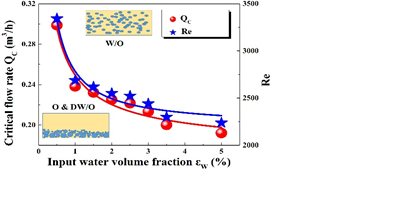
Recent Publications:
- Feng X, Wu SX, Zhao K, Wang W, Zhan HL, Jiang C, Xiao LZ, Chen SH (2015) Pattern transitions of oil-water two-phase flow with low water content in rectangular horizontal pipes probed by Terahertz Spectrum. Optical Express 23:A1693-1699.
- Song Y, Zhan HL, Zhao K, Miao XY, Lu ZQ, Bao RM, Zhu J, Xiao LZ (2016) Simultaneous characterization of water content and distribution in high water cut crude oil. Energy & Fuels 30:3929-3933.
- Zhan HL, Wu SX, Bao RM, d, Ge LN, Zhao K (2015) Qualitative identification of crude oils from different oil fields using terahertz time-domain spectroscopy. Fuel 143:189-193.
- Jiang C, Zhao K, Zhao LJ, Jin WJ, Yang YP, Chen SH (2014) Probing Disaggregation of Crude Oil in a Magnetic Field with Terahertz Time-Domain Spectroscopy. Energy & Fuels 28: 483-487.
- Jiang C, Zhao K, Fu C, Xiao LZ (2017) Characterization of morphology and structure of wax crystals in waxy crude oils by terahertz time-domain spectroscopy. Energy & Fuels 31:1416–1421.
Dhruvin Kaneria
Pandit Deendayal Petroleum University, India
Title: Velocity anisotropy and geomechanical characterization of Cambay Shale, Cambay Basin, Gujarat, India
Time : 15:35-15:55

Biography:
Dhruvin Kaneria is an Oil and Gas innovator, graduating in Petroleum Engineering from Pandit Deendayal Petroleum University. He has presented more than 5 papers in various universities in India. His ongoing research includes Cambay Shale geomechanics, proppant conductivity and on new ideas like Internet of things and laser technology which could possibly change oil and operations.
Abstract:
The Cambay Basin is an intracratonic basin located along the western continental passive margin of Indian platform of Western Indian State of Gujarat. It has been prognosticated as the main shale gas reservoirs with resource potential of around 231 BCF/mi2, high organic matter content (3.0%), complex lithology-stratigraphy and anisotropy. It is very difficult to understand the mineral assemblage, zone of weakness, fracture alignment and stress orientation in this unconventional reserve. The tectonic block chosen for investigation is Ahmedabad-Mehsana Tectonic Block (North Cambay Basin) of Cambay Basin, India. In the study, a directional dependence of the velocity of seismic waves (P and S waves) in the horizontal and vertical core plugs of Cambay Shale has been studied at different confining pressure (i.e., from 250 psi to 3000 psi) to understand the preferential orientation of mineral, microcracks, fracture alignment across the bedding plane and porosity. The elastic stiffness constants and Thomsen's parameters are calculated and plotted against the different confining pressure on both the plugs. The variation of velocities indicates the anisotropic nature of this shale and the same has been validated by the results of Single Stage Triaxial Geomechanical Test.
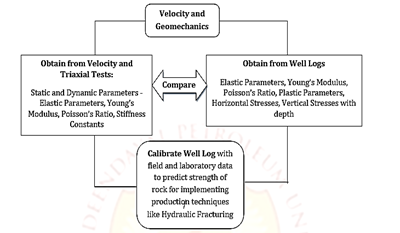
Figure-1: Well log and laboratory data comparison.
Yakubu Musah Muntaka
University of Professional Studies, Ghana
Title: Emerging oil and gas in Africa, the case of Ghana and the way forward

Biography:
Yakubu Musah muntaka is my name, Ghanaian by citizen. I had my elementary school at St. Peters international school early 1999s and later finished my junior high school at kings international school in 2004. I then proceeded to Adventist senior high school where I completed with distinction in May 2008. I then moved further to the university of professional studies, Accra where I had my first degree in Business Administration and held various leadership position as the local NUGS President where I completed in August 2013. A year after I did my compulsory national service at the National Health Insurance Scheme( NHIS) as an assistant administrator. I later moved to Milito Enterprise at Dworwulu as an administrator IN MAY 2015. After two years I established my own enterprise, YM ventures which deals with import and export of general goods. Currently im offering my Masters programme in oil and gas at the university of professional studies, Accra. My passion is to serve my country, for the matter am also working Galaxy oil as an assistant administrator which is a Ghanaian owned oil and gas company.
Abstract:
Ghana was the first sub-Sahara country to gain independence (1957). In the early 1990s, after a long period of military rule, Ghana became a democratic state. Since then, it has been regarded as one of the most stable African democracies. The level of corruption is quite low, there are no violent conflicts and the macroeconomic structure is relatively strong. GDP is around US$38,24 billion, while the total state revenues, including grants, are approximately 30% of GDP. In 2004 the country sold licenses for offshore oil exploration and production to different international companies. In July 2007, Tullow Oil and Kosmos Energy discovered oil in commercial quantities in the western region of Ghana, named as “Jubilee Field”. Development of the production site started right away and in December 2010 oil production was officially launched. The Tweneboa field seems to be a second major discovery. It is spread out in the Deepwater Tano and West Cape Three Points blocks. The field covers 110 km², which is about the size of 155 football pitches. The Tweneboa field (6 km east of Jubilee) was discovered in March 2009. In July 2010 the Owo-1 drilling confirmed the reasonably big amounts of the field. A maximum depth of 4,000 meters has been drilled. There does not seem to be an underwater channel connection between the Tweneboa and the Jubilee field. Apart from these major findings, there are also several smaller wells close by. In particular the Owo-1 well in the Tweneboa field and the small Dana GH Western Tano field are located very close to the Côte d’Ivoire border. For these drillings precise locations have not been made public, but all the exact coordinates of the Jubilee wells have been published and it seems clear that they are within Ghanaian territory [Ghanaweb.com, 2010(I)] The Jubilee Field the figures of the amount of oil expected in the Jubilee field, published by Ghanaian newspapers, vary between 1 and 2 billion barrels of crude oil. In their status report 2008, the state owned Ghana National Petroleum Company (GNPC) published figures stating that 800 million barrels of oil is the total field amount, with an upside potential of 3 billion barrels of oil [GNPC, 2008].
Tianyao Hao
Chinese Academy of Sciences, China
Title: Magnetic basement and its petroleum geological significance in Sichuan Basin

Biography:
Tianyao Hao is a Researcher at the Institute of Geology and Geophysics, Chinese Academy of Sciences, Deputy Editor of Chinese Journal of Geophysics and she is mainly engaged in integrated geophysical research in the sea-land oil and gas basin. In recent years, she has been focused on the application of non-seismic methods in oil and gas basin research, integrated geophysical research of pre-Cenozoic residual basins, integrated geophysical research of deep structure and fault system in Chinese seas and development of submarine geophysical exploration equipment.
Abstract:
Sichuan Basin is the basin with the largest number of proven gas reserves, the number of gas fields found and the cumulative output of gas in China. The study of basement structure of the basin is very important in the deep oil and gas exploration. The research concerned on the structure of Sichuan basin’s basement based on aeromagnetic data. We improved the method of determining the residual magnetization direction by the maximum cross-correlation method based on the vertical gradient and the total gradient of the magnetic anomaly. This reduction to the pole (RTP) method of magnetic anomalies considering the residual magnetization direction makes the result more reliable. We obtained residual basement magnetic anomaly (RBMA) from aeromagnetic data, then inverted the undulating magnetic basement and its susceptibility distribution, divided the magnetic basement of Sichuan Basin into 7 parts and discussed the controlling effect of Sichuan basin’s magnetic basement on oil and gas migration and accumulation. Besides, the basement faults system was patterned with the help of the directional derivative, vertical derivative and horizontal gradient of the RBMA. The magnetic basement obtained in this paper is the top interface of lower mesoproterozoic with a depth of 3~10 km, which reflects the tectonic morphology and undulating characteristics of the deep metamorphic crystalline basement in the basin. The large inherited paleo-uplift developed on the magnetic basement uplift provides the conditions for the formation and aggregation of the pre-Cenozoic oil and gas.
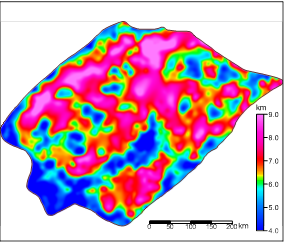
Figure-1: The depth of magnetic basement in the Sichuan Basin.
Recent Publications
- Liu K, Hao TY (2014) Application of potential field method in the unconventional oil and gas exploration. Progress in Geophysics 29(2): 786-797.
- Shi L, Meng XH, Guo LH, Chen S, Xu WM (2014) A simple algorithm for estimating the magnetization direction of magnetic bodies under the influence of remanent magnetization. Progress in Geophysics 29(4):1748-1751.
- Hao TY, Xu Y, Zhao BM, Zhang YJ, Peng LL (2009) Geophysical research on distribution features of magnetic basements in the South China Sea. Chinese Journal Geophysics 52(11): 2763-2774.
- Cooper GRJ, Cowan DR (2005) Differential reduction to the pole. Computers & Geosciences 31:989–999.
- Neal D, Li YG (2006) A new method for determination of magnetization direction. Geophysics 71(6):69-73.









